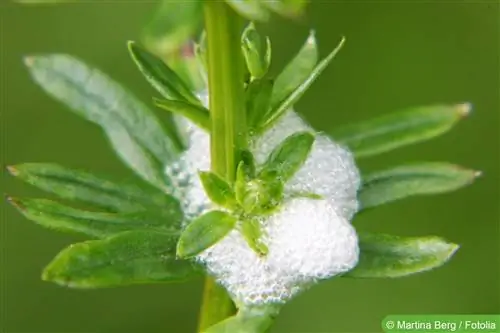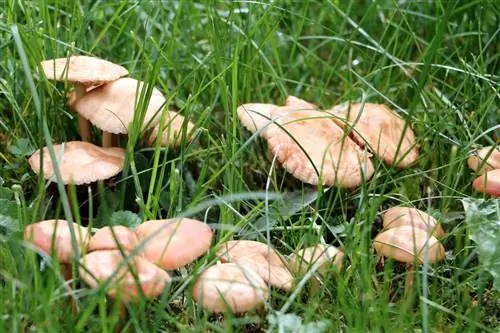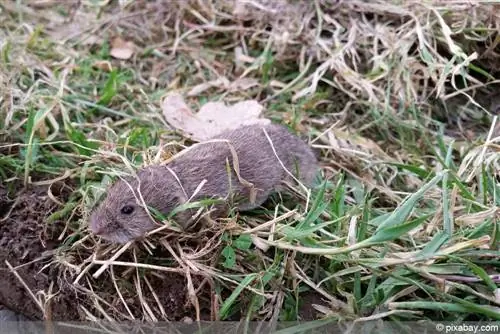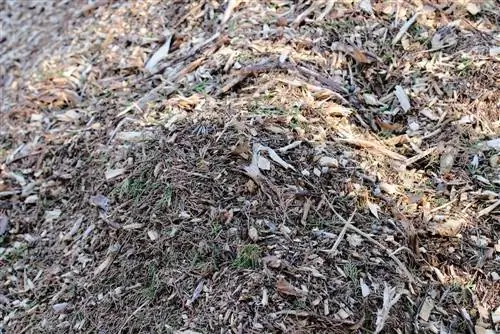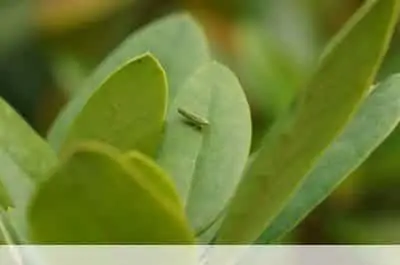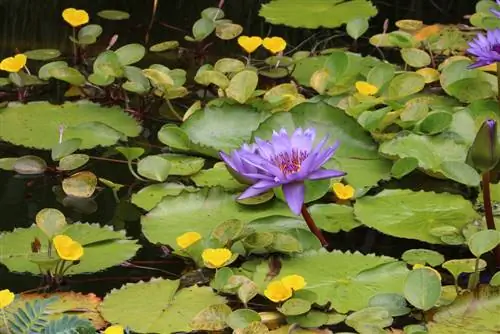- Author admin [email protected].
- Public 2023-12-17 03:39.
- Last modified 2025-06-01 06:48.
If you're out and about in riparian forests or near bodies of water in June, you might find yourself suddenly getting dripping wet under a tree, even though it's not raining at all. The phenomenon is caused by small insects that feast on the plant juices. The larvae of leafhoppers pierce stalks of grass or the shoots of trees and feed on their juices. And like some other parasites, Aphrophoridae can occasionally transmit diseases. In addition, harmful fungi sometimes penetrate the affected plants through the wounds.
Short profile
- Latin name: Aphrophoridae
- belong to the family Cercopoidae within the round-headed cicadas
- mostly inconspicuously brownish to black in color
- long or wide oval body shape
- one or two thorns on the hind legs
- two point eyes and a pair of compound eyes
- bristle-shaped antennae
- adult foam cicadas can fly and jump very well
Diet
Foam cicadas, like all cicadas, have a proboscis through which they absorb their food. They feed on plant juices and are not very picky about their host plants. The leafhoppers pierce certain parts of the plant and suck up the rising sap like through a straw. While most species of leafhoppers primarily attack grasses, rushes and herbaceous plants, the genus Aphrophora also feeds on woody plants.
Reproduction and development
After mating, female cicadas lay their eggs in the soil or in the tissue of the host plant. From this, the larvae develop into adult insects through various stages. Since the small animals feed on the rising plant sap, which has very little nutritional value, a high throughput is necessary. Therefore, large amounts of excess fluid are usually excreted. In the case of leafhopper larvae, this protein-containing liquid is mixed with air bubbles from the respiratory cavity. In this way they create entire foam nests on the plant. The foam, so-called cuckoo saliva or witch spit, serves as protection from enemies on the one hand, and on the other hand it maintains the necessary moisture and temperature for the larvae to develop further. However, it is not real saliva; the vesicular secretion is excreted by the larvae through the anus. This foam is neither poisonous nor will it harm the plant in any way.
By the way:
All male and some female cicadas are able to produce a rhythmic song, the typical chirping of cicadas, with special drum organs on their abdomen.
Harmful effects
Central European Aphrophoridae cannot actually be described as pests. In many plants, the rather coarse puncture wounds only lead to callus formation. The bulging tissue that forms at the suction scars is called a callus. Depending on the number of cicadas and the location where the scars form, the susceptibility of the branches to break increases. This is particularly dangerous with larger trees such as willow trees. If eggs are laid extremely densely, the shoots may also wilt. In addition, the penetration of harmful fungi is encouraged. In rare cases, it is possible that the leafhoppers transmit pathogens while sucking. Identifying features of a foam leafhopper infestation are:
- Foam nests on the affected plant (from May or June)
- so-called “bleeding willows”: here the infestation is so great that the plant sap drips out of the willow
- chirping songs reminiscent of crickets
- When the shoots are touched, the frightened animals fly away in droves
- Buds on plants die and turn brown (bud tan)
- Callus formation on woody shoots
- silvery-white dots on the leaves
Tip:
If shoots or buds die due to a leafhopper infestation, pathogens or fungi have usually penetrated the plant. Action must be taken as early as possible and all shoots must be cut back to he althy wood. Dispose of the cuttings in household waste - and never in organic waste or compost.
Combat

Cicadas like the foam cicada are actually an indicator of an intact ecosystem and do not necessarily need to be controlled. Only when the population appears in large numbers do the foam cicadas become a nuisance, as they not only crawl around all over the plants, but also make loud songs. There is also a risk of infections with pathogens that can sneak into the plant through the wounds and cause the plant to die. A very severe infestation sometimes causes the shoots to wilt (due to the loss of fluid). In these cases, action must be taken.
Removing larvae
The foam in which the foam leafhopper larvae are found can easily be rinsed off with the hard jet of a garden hose. This measure makes it more difficult for the larvae to survive. Meadowfoam leafhoppers are usually at work on roses and perennials. They don't necessarily do any harm, but they do pose a visual problem. If herbs or strawberries are attacked, the larvae can be carefully rinsed off so as not to injure the plants and fruits. This process should be repeated several times to really rinse all the larvae from the plant.
Tip:
The foam and the cicada larvae are neither poisonous nor do they pose any other he alth problem for humans.
Encourage predators
Depending on the type of cicada and its body size, the small animals usually remain undetected for a long time. If you want to fight the flying, adult foam leafhoppers, you should be prepared for a lengthy but not really difficult fight. Aphrophoridae have a wide range of natural predators. It is important to specifically attract and encourage them into the garden. But not all gardens provide suitable living conditions for beneficial insects. Natural gardens that are not only planted with various wildflowers but also offer nesting places and hiding places (stones, piles of branches) are best suited. If you want to introduce beneficial insects, you should avoid using pesticides entirely. Enemies of the Aphrophoridae are:
- Predator bugs
- Spiders
- Ants
- Birds
- Digger wasps
Insert yellow boards
Many flying pests can be attracted by a special yellow color. This phenomenon is used in yellow boards to catch the insects. The yellow panels do not contain any insecticides or other poisons; they are simply coated with an odorless special glue that neither dries nor begins to drip at higher temperatures. Whiteflies, fungus gnats and also leafhoppers fly to the yellow boards and stick to the glue. In this way, the leafhoppers can no longer multiply and therefore do not cause any damage to the plants.
- use right at the start of cultivation
- always hang over the cultivated plants
- also suitable for the greenhouse or windowsill
- does not harm the beneficial insects
- the adhesive ability is not affected by water
- can be used all year round
- replace if necessary
- only catch the adult cicadas
- The larvae must be de alt with separately
Remedies against sucking insects
If the infestation is very severe, it makes sense to use a remedy against the larvae in addition to yellow plates for the adult leafhoppers. In principle, all remedies against sucking insects such as aphids work on foam leafhopper larvae. It is best to use a product with essential oils or liverwort extract and avoid chemical agents so as not to disturb the biological balance in the garden.
Neemoil
Neem oil, also known as neem oil, is a purely ecological product that is made from the seeds of the neem tree. It helps against a wide variety of pests in the home and garden and is very easy to use.
- sprayed on neem oil helps against acute infestation
- in irrigation water it strengthens the plant from the inside out
- Beneficial insects are in no way endangered
- Make a solution from a few drops of neem oil per liter of water
- spray on the leaves (including the underside of the leaves)
- Add to irrigation water (preventive effect)
- If necessary, first rinse off foam pockets with the garden hose
- do not use in rain or strong sunshine
Tip:
The larvae of the foam cicada do not die immediately, but only after a few days. In most cases, the plant is not free of pests after being sprayed once and the procedure has to be repeated several times.
Species and distribution
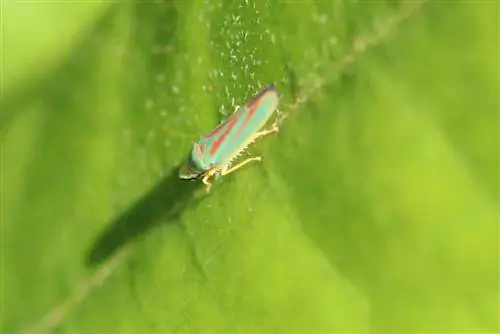
Aphrophoridae live everywhere in the world except the Arctic and Antarctic. A particularly large number of the approximately 850 species occur in the tropics. Some foamhoppers prefer moist areas and live near bodies of water or meadows, others live in dry areas. We have four genera of foam leafhoppers. The small insects are usually named after their area of distribution or the host plant they prefer to attack. For this reason, these plants in particular are threatened. The following foam cicadas are native to us:
Aphrophora (relatively large species up to 12.5 cm long)
- Alder leafhopper (Aphrophora alni)
- Pine foamhopper (A. corticea)
- Alpine cicada (A. major)
- Colorful willow leafhopper (A. pectoralis)
- Brown willow leafhopper (A. salicina)
Lepyronia (wide oval body shape)
Wicked cicada (Lepyronia coleoptrata), shimmers bluish
Neophilaenus (genus with the most species, significantly slimmer body shape)
- Zwenkenfoam cicada (Neophilaenus albipennis)
- Field leafhopper (N. campestris)
- Forest cicada (N. exclamationis)
- Steppe cicada (N. infumatus)
- Foamhopper (N. lineatus)
- Dwarf leafhopper (N. minor)
- Cicada (N. modestus)
Philaenus (wide oval body shape)
Meadowfoam cicada (Philaenus spumarius)
Conclusion
Foam cicadas are extremely fascinating and mostly completely harmless insects that feed on plant juices. Control is only necessary in exceptional cases, for example in the event of a mass infestation. Foam leafhoppers can be controlled with common remedies such as yellow tablets or neem oil. However, a little patience is required here, as success only comes after some time.

